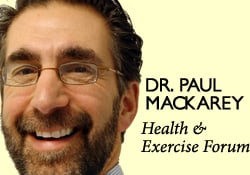 Guest Columnist: Janet Caputo, PT, OCS
Guest Columnist: Janet Caputo, PT, OCS
Are you hyperflexible? Do people call you a contortionist? Are you the main attraction at parties, like Dominique DelPrete and Amy Simrell Mifka, because you entertain your friends by twisting your arms and legs in gross directions? Do you excel in dance and gymnastics because of your exceptional joint mobility? If you answered “yes” to any of these questions, you may be a hypermobile individual.
Considerable joint laxity is typically more evident in females and younger individuals, but if you are curious about your level of flexibility, take this quick and easy test. If you score 4 or more, you are considered hypermobile (too much mobility/flexibility). The Beighton score1 is calculated as follows:
1. Score one point if you can bend forward and place your hands flat on the floor without bending your knees (see photo).
2. Score one point if your knees will bend backwards (see photo).
3. Score one point for each elbow that will bend backwards (see photo).
4. Score one point for each thumb that will bend backwards to touch the forearm (see photo).
5. Score one point for each hand when you can bend the little finger back beyond 90-degrees (see photo).
Hypermobility is more of a liability than an asset. First, your excessive flexibility can predispose you to musculoskeletal injuries. Second, repetitious and inappropriate use of hypermobile joints causes inflammatory conditions (e.g. tendonitis, bursitis, fasciitis). Third, recurrent sprains, strains, subluxations, and dislocations of the shoulders, knees, ankles, hips, and temporomandibular joints of the jaw (TMJ) lead to chronic, widespread pain. This pain usually develops early in life, progresses over time, and can be debilitating. Early onset of osteoarthritis, a consequence of excessive joint mobility, contributes to chronic pain. If persistent pain interferes with your ability to be physically active, your bone density may diminish.
Hypermobile individuals should be aware of certain activities and situations that make your joints vulnerable to injury and should therefore be avoided. First, since you are not in the circus, stop demonstrating your flexibility with all those funky, weird positions. Second, avoid high-impact, contact, or collision sports (e.g. football, soccer, rugby, and gymnastics), as they increase your risk of joint damage. Third, maintain a healthy weight, because obesity increases stress on your joints and makes your muscles work harder.
One of the best ways for hypermobile individuals to protect their joints is to practice proper posture. Sit and stand tall—do not slouch! Pretend you are a soldier standing at attention with your chin in, shoulders back, and chest out. A sway-back posture with your hips thrust forward and your knees locked backward strains your back and the joints in your legs. Sitting in the “W” position or “Indian style” stresses your knees and is not recommended. Kneeling with your buttocks on your heels while your ankles are pointed downward can injure your knees and ankles. Since most individuals with joint hypermobility have flat feet, throw out those flip-flops, and wear stable footwear with good motion control.
Performing activities with good posture and alignment is called “proper body mechanics,” and these techniques can minimize joint problems. Use a “weight-lifter’s squat” for lifting, which will help protect your spine. Carry objects with your elbows at the sides of your body, instead of reaching out, to reduce stress on your spine and shoulders. Adjust the height of your work surfaces during prolonged tasks (i.e. using computer) to lessen stress on your joints and strain to your muscles. Alternate tasks and schedule regular rest periods to reduce pain and muscle fatigue. Avoid sustained positions, and further minimize joint deterioration by lifting and carrying light loads, and using a hand truck or luggage cart to transport heavier objects.
Improving your strength will help compensate for your joint instability. Next week, read Part 2 of 3, which will provide exercises that improve core stability and help protect hypermobile joints.
Photos: Jennifer Hnatko.
Models: Dominiqe DelPrete, Amy Simrell Mifka, Alexa Merrill.
Guest Columnist: Janet Caputo, PT, OCS specializes in orthopedic and neurological rehabilitation as clinic director at Mackarey & Mackarey Physical Therapy Consultants, LLC. She is presently pursuing a doctor of physical therapy degree at the University of Scranton.
Read “Health & Exercise Forum” – Every Monday. This article is not intended as a substitute for medical treatment. If you have questions related to your medical condition, please contact your family physician. For further inquires related to this topic email: drpmackarey@msn.com. Paul J. Mackarey PT, DHSc, OCS is a Doctor in Health Sciences specializing in orthopaedic and sports physical therapy. Dr. Mackarey is in private practice and is an affiliate faculty member at the University of Scranton, PT Dept.
Reference: Keer R, Grahame, R, eds. Hypermobility Syndrome. Recognition and Management for Physiotherapists. London: Butterworth Heinemann; 2003.